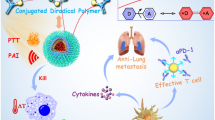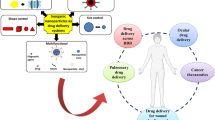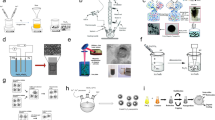Abstract
Recent advances in the research on the molecular mechanism of cell death and methods for preparation of nanomaterials make the integration of various therapeutic approaches, targeting, and imaging modes into a single nanoscale complex a new trend for the development of future nanotherapeutics. Hence, a novel ellipsoidal composite nanoplatform composed of a magnetic Fe3O4/Fe nanorod core (~120 nm) enwrapped by a catalase (CAT)-imprinted fibrous SiO2/ polydopamine (F-SiO2/PDA) shell with thickness 70 nm was prepared in this work. In vitro experiments showed that the Fe3O4/Fe@F-SiO2/PDA nanoparticles can selectively inhibit the bioactivity of CAT in tumor cells by the molecular imprinting technique. As a result, the H2O2 level in tumor cells was elevated dramatically. At the same time, the Fe3O4/Fe core released Fe ions to catalyze the conversion of H2O2 to ·OH in tumor cells. Eventually, the concentration of ·OH in tumor cells rapidly rose to a lethal level thus triggering apoptosis. Combined with the remarkable near-infrared light (NIR) photothermal effect of the CAT-imprinted PDA layer, the Fe3O4/Fe@F-SiO2/PDA nanoparticles can effectively kill MCF-7, HeLa, and 293T tumor cells but are not toxic to nontumor cells. Furthermore, these nanoparticles show good capacity for magnetic targeting and suitability for magnetic resonance imaging (MRI). Therefore, the integrated multifunctional nanoplatform opens up new possibilities for high-efficiency visual targeted nonchemo therapy for cancer.

Similar content being viewed by others
References
Trachootham, D.; Alexandre, J.; Huang, P. Targeting cancer cells by ROS-mediated mechanisms: A radical therapeutic approach. Nat. Rev. Drug Discov. 2009, 8, 579–591.
Naidu, M. U. R.; Ramana, G. V.; Rani, P. U.; Mohan, I. K.; Suman, A.; Roy, P. Chemotherapy-induced and/or radiation therapy-induced oral mucositis-complicating the treatment of cancer. Neoplasia 2004, 6, 423–431.
Yun, J.; Mullarky, E.; Lu, C. Y.; Bosch, K. N.; Kavalier, A.; Rivera, K.; Roper, J.; Chio, I. I. C.; Giannopoulou, E. G.; Rago, C. et al. Vitamin C selectively kills KRAS and BRAF mutant colorectal cancer cells by targeting GAPDH. Science 2015, 350, 1391–1396.
Huang, P.; Feng, L.; Oldham, E. A.; Keating, M. J.; Plunkett, W. Superoxide dismutase as a target for the selective killing of cancer cells. Nature 2000, 407, 390–395.
Kawanishi, S.; Hiraku, Y.; Pinlaor, S.; Ma, N. Oxidative and nitrative DNA damage in animals and patients with inflammatory diseases in relation to inflammation-related carcinogenesis. Biol. Chem. 2006, 387, 365–372.
Pal, S.; Dey, S. K.; Saha, C. Inhibition of catalase by tea catechins in free and cellular state: A biophysical approach. PLoS One 2014, 9, e102460.
Giorgio, M.; Trinei, M.; Migliaccio, E.; Pelicci, P. G. Hydrogen peroxide: A metabolic by-product or a common mediator of ageing signals. Nat. Rev. Mol. Cell Biol. 2007, 8, 722–728.
Yang, L.; Zheng, X. L.; Sun, H.; Zhong, Y. J.; Wang, Q.; He, H. N.; Shi, X. W.; Zhou, B.; Li, J. K.; Lin, Y. et al. Catalase suppression-mediated H2O2 accumulation in cancer cells by wogonin effectively blocks tumor necrosis factorinduced NF-κB activation and sensitizes apoptosis. Cancer Sci. 2011, 102, 870–876.
Murphy, M. P. How mitochondria produce reactive oxygen species. Biochem. J. 2009, 417, 1–13.
Kwon, B.; Han, E.; Yang, W.; Cho, W.; Yoo, W.; Hwang, J.; Kwon, B. M.; Lee, D. Nano-Fenton reactors as a new class of oxidative stress amplifying anticancer therapeutic agents. ACS Appl. Mater. Interfaces 2016, 8, 5887–5897.
Huang, G.; Chen, H. B.; Dong, Y.; Luo, X. Q.; Yu, H. J.; Moore, Z.; Bey, E. A.; Boothman, D. A.; Gao, J. M. Superparamagnetic iron oxide nanoparticles: Amplifying ROS stress to improve anticancer drug efficacy. Theranostics 2013, 3, 116–126.
Fenton, H. J. H. Oxidation of tartaric acid in presence of iron. J. Chem. Soc., Trans. 1894, 65, 899–910.
Kato, Y.; Ozawa, S.; Miyamoto, C.; Maehata, Y.; Suzuki, A.; Maeda, T.; Baba, Y. Acidic extracellular microenvironment and cancer. Cancer Cell Int. 2013, 13, 89.
Zhang, C.; Bu, W. B.; Ni, D. L.; Zhang, S. J.; Li, Q.; Yao, Z. W.; Zhang, J. W.; Yao, H. L.; Wang, Z.; Shi, J. L. Synthesis of iron nanometallic glasses and their application in cancer therapy by a localized Fenton reaction. Angew. Chem., Int. Ed. 2016, 55, 2101–2106.
Wang, J.; Liu, J.; Liu, Y.; Wang, L. M.; Cao, M. J.; Ji, Y. L.; Wu, X. C.; Xu, Y. Y.; Bai, B.; Miao, Q. et al. Gd-hybridized plasmonic Au-nanocomposites enhanced tumor-interior drug permeability in multimodal imaging-guided therapy. Adv. Mater. 2016, 28, 8950–8958.
Yu, J.; Ju, Y. M.; Zhao, L. Y.; Chu, X.; Yang, W. L.; Tian, Y. L.; Sheng, F. G.; Lin, J.; Liu, F.; Dong, Y. H. et al. Multistimuli-regulated photochemothermal cancer therapy remotely controlled via Fe5C2 nanoparticles. ACS Nano 2016, 10, 159–169.
Tian, Q. W.; Wang, Q.; Yao, K. X.; Teng, B. Y.; Zhang, J. Z.; Yang, S. P.; Han, Y. Multifunctional polypyrrole@Fe3O4 nanoparticles for dual-modal imaging and in vivo photothermal cancer therapy. Small 2014, 10, 1063–1068.
Wang, M. S.; He, L.; Xu, W. J.; Wang, X.; Yin, Y. D. Magnetic assembly and field-tuning of ellipsoidal-nanoparticlebased colloidal photonic crystals. Angew. Chem., Int. Ed. 2015, 54, 7077–7081.
Xie, Y. Y.; Wang, J.; Wang, M. Z.; Ge, X. W. Fabrication of fibrous amidoxime-functionalized mesoporous silica microsphere and its selectively adsorption property for Pb2+ in aqueous solution. J Hazard. Mater. 2015, 297, 66–73.
Chen, J. X.; Lei, S.; Xie, Y. Y.; Wang, M. Z.; Yang, J.; Ge, X. W. Fabrication of high-performance magnetic lysozymeimprinted microsphere and its NIR-responsive controlled release property. ACS Appl. Mater. Interfaces 2015, 7, 28606–28615.
Yue, Q.; Li, J. L.; Luo, W.; Zhang, Y.; Elzatahry, A. A.; Wang, X. Q.; Wang, C.; Li, W.; Cheng, X. W.; Alghamdi, A. et al. An interface coassembly in biliquid phase: Toward core–shell magnetic mesoporous silica microspheres with tunable pore size. J. Am. Chem. Soc. 2015, 137, 13282–13289.
Zhang, S. F.; Wu, W.; Xiao, X. H.; Zhou, J.; Ren, F.; Jiang, C. Z. Preparation and characterization of spindle-like Fe3O4 mesoporous nanoparticles. Nanoscale Res. Lett. 2011, 6, 89.
Cui, Z. M.; Chen, Z.; Cao, C. Y.; Jiang, L.; Song, W. G. A yolk-shell structured Fe2O3@mesoporous SiO2 nanoreactor for enhanced activity as a Fenton catalyst in total oxidation of dyes. Chem. Commun. 2013, 49, 2332–2334.
Li, X.; Gai, F. Y.; Guan, B. Y.; Zhang, Y.; Liu, Y. L.; Huo, Q. S. Fe@C core–shell and Fe@C yolk–shell particles for effective removal of 4-chlorophenol. J. Mater. Chem. A 2015, 3, 3988–3994.
Mao, G.-Y.; Bu, F.-X.; Wang, W.; Jiang, D.-M.; Zhao, Z.-J.; Zhang, Q.-H.; Jiang, J.-S. Synthesis and characterization of γ-Fe2O3/C nanocomposite as an efficient catalyst for the degradation of methylene blue. Desalin. Water Treat. 2016, 57, 9226–9236.
Li, M. K.; Qiang, Z. M.; Pulgarin, C.; Kiwi, J. Accelerated methylene blue (MB) degradation by Fenton reagent exposed to UV or VUV/UV light in an innovative micro photoreactor. Appl. Catal. B: Environ. 2016, 187, 83–89.
Moura, F. C. C.; Araujo, M. H.; Costa, R. C. C.; Fabris, J. D.; Ardisson, J. D.; Macedo, W. A. A.; Lago, R. M. Efficient use of Fe metal as an electron transfer agent in a heterogeneous Fenton system based on Fe0/Fe3O4 composites. Chemosphere 2005, 60, 1118–1123.
Liu, X. J.; Li, B.; Fu, F. F.; Xu, K. B.; Zou, R. J.; Wang, Q.; Zhang, B. J.; Chen, Z. G.; Hu, J. Q. Facile synthesis of biocompatible cysteine-coated CuS nanoparticles with high photothermal conversion efficiency for cancer therapy. Dalton Trans. 2014, 43, 11709–11715.
Cai, X. J.; Jia, X. Q.; Gao, W.; Zhang, K.; Ma, M.; Wang, S. G.; Zheng, Y. Y.; Shi, J. L.; Chen, H. R. A versatile nanotheranostic agent for efficient dual-mode imaging guided synergistic chemo-thermal tumor therapy. Adv. Funct. Mater. 2015, 25, 2520–2529.
Tian, Q. W.; Jiang, F. R.; Zou, R. J.; Liu, Q.; Chen, Z. G.; Zhu, M. F.; Yang, S. P.; Wang, J. L.; Wang, J. H.; Hu, J. Q. Hydrophilic Cu9S5 nanocrystals: A photothermal agent with a 25.7% heat conversion efficiency for photothermal ablation of cancer cells in vivo. ACS Nano 2011, 5, 9761–9771.
Li, L. L.; Liang, K. X.; Hua, Z. T.; Zou, M.; Chen, K. Z.; Wang, W. A green route to water-soluble polyaniline for photothermal therapy catalyzed by iron phosphates peroxidase mimic. Polym. Chem. 2015, 6, 2290–2296.
Acknowledgements
We thank Prof. Zhishen Ge of the Department of Polymer Science and Engineering of USTC, Prof. Yu Zhao of Department of Plastic Surgery, The First Affiliated Hospital of Anhui Medical University, and Prof. Yinfeng Qian of Department of Radiology, The First Affiliated Hospital of Anhui Medical University for their kind help in providing the 808 nm semiconductor laser device, adipose-derived stem cells, and the instruction of MRI testing, respectively. This work was supported by the National Natural Science Foundation of China (Nos. 51103143, 51173175, 51473152, and 51573174), the Fundamental Research Funds for the Central Universities (Nos. WK2060200012 and WK3450000001).
Author information
Authors and Affiliations
Corresponding authors
Electronic supplementary material
12274_2017_1431_MOESM1_ESM.pdf
Catalase-imprinted Fe3O4/Fe@fibrous SiO2/polydopamine nanoparticles: An integrated nanoplatform of magnetic targeting, magnetic resonance imaging, and dual-mode cancer therapy
Rights and permissions
About this article
Cite this article
Chen, J., Lei, S., Zeng, K. et al. Catalase-imprinted Fe3O4/Fe@fibrous SiO2/polydopamine nanoparticles: An integrated nanoplatform of magnetic targeting, magnetic resonance imaging, and dual-mode cancer therapy. Nano Res. 10, 2351–2363 (2017). https://doi.org/10.1007/s12274-017-1431-8
Received:
Revised:
Accepted:
Published:
Issue Date:
DOI: https://doi.org/10.1007/s12274-017-1431-8




